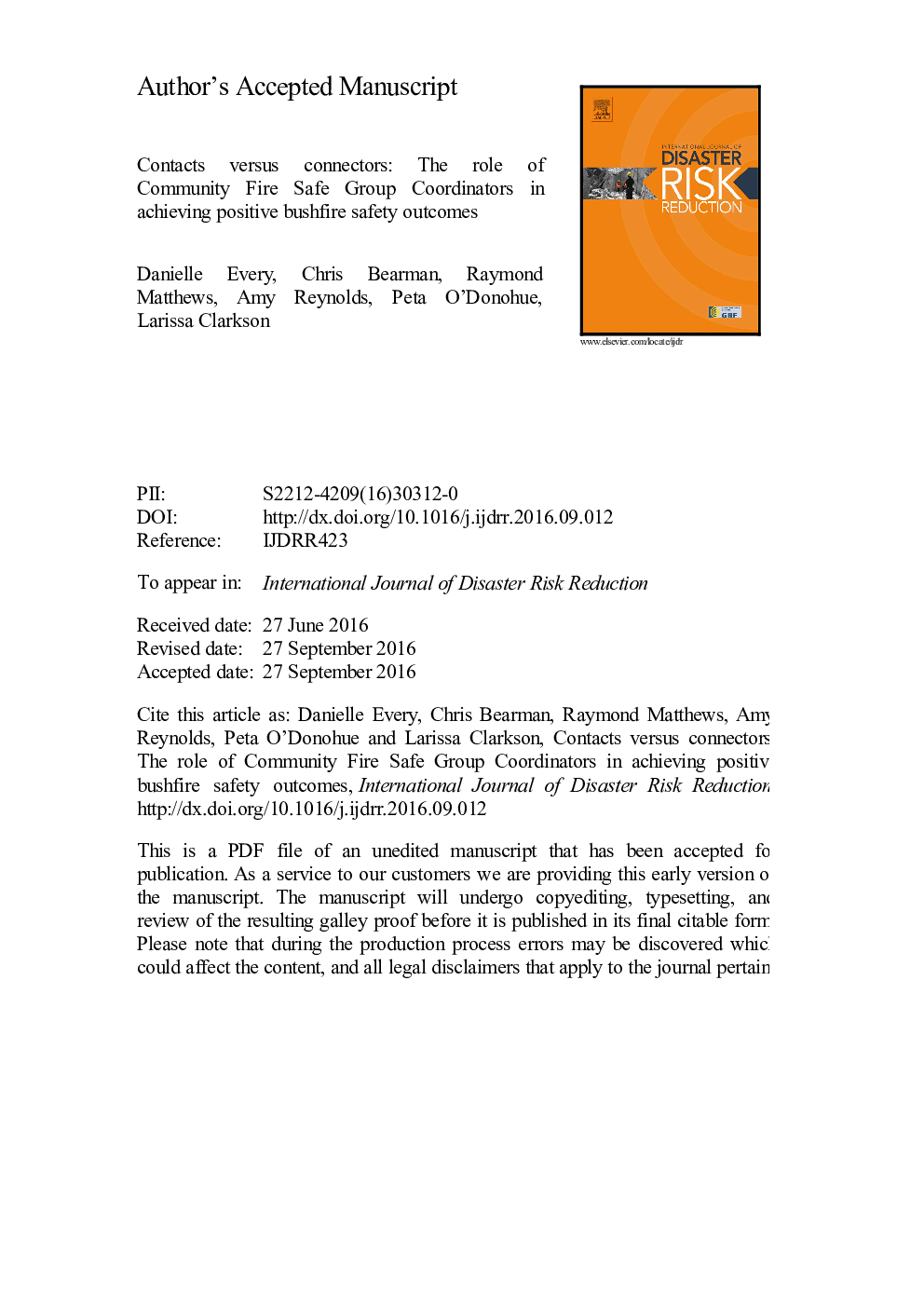| کد مقاله | کد نشریه | سال انتشار | مقاله انگلیسی | نسخه تمام متن |
|---|---|---|---|---|
| 7472480 | 1485151 | 2016 | 24 صفحه PDF | دانلود رایگان |
عنوان انگلیسی مقاله ISI
Contacts versus connectors: The role of Community Fire Safe Group coordinators in achieving positive bushfire safety outcomes
ترجمه فارسی عنوان
اطلاعات در مقابل اتصالات: نقش هماهنگ کننده گروه ایمنی گروهی در دستیابی به نتایج ایمنی مصنوعی آتش نشانی
دانلود مقاله + سفارش ترجمه
دانلود مقاله ISI انگلیسی
رایگان برای ایرانیان
ترجمه چکیده
مسئولیت مشترک برای آمادگی بوشهر شامل جوامع متعهد با مهارت، دانش و توانایی برای به حداقل رساندن تأثیر بسوزی در خانه ها، خواص و جامعه می باشد. گروه های آمادگی جامعه یک روش بالقوه موثر برای دستیابی به این اعتماد به نفس هستند. تحقیقات قبلی نشان می دهد که این گروه ها دانش و آگاهی مردم از خطر، برنامه ریزی و آماده سازی آن، انسجام و همکاری اجتماعی را افزایش می دهند. با این حال، این نتایج برای همه گروه ها در همه مکان ها نیست. گروه ها به یک مشکل چند ساله مشغولند و مشارکت کم و خرید در منطقه را به دلیل تفاوت های فردی در تمایل به بخشی از یک گروه، سطح پایین آگاهی ریسک، هتک حرمت اجتماعی و سرمایه کم اجتماعی مواجه می کنند. این مقاله پیشنهاد می کند که مهارت ها و ویژگی های هماهنگ کننده گروه در پاسخ دادن به این چالش ها و غلبه بر این چالش ها برای کل طول عمر، همکاری و موفقیت گروه ها باشد. با استفاده از مصاحبه ها و نظرسنجی با هماهنگ کنندگان گروه های ایمنی جامعه ایمنی و اعضای تحت تاثیر آتش سمبسون تخت 2015 در جنوب استرالیا، ما عناصر کلیدی هماهنگی موفق را در معرض فعالیت ساکنان محله، تازه واردان و افرادی قرار دادیم که از چهره نیستند ارتباط چهره و شخصی سازی متناسب با نیازهای مختلف مردم است. این تعامل فعال و قطعی در برقراری ارتباط با ایمنی بوشهر، با درک این نکته که انگیزه منفی را می توان برطرف کرد، تحقق یافته و انگیزه ی آن، نقش کلیدی هماهنگ کننده گروه است. آموزش برای هماهنگ کننده ها در گروه فردی و گروهی فرآیندهای پایه ای تغییر رفتار، در ارتباطات شخصی و تطبیق مواد برای گروه های گوناگون احتمالا موجب بهبود نتایج گروه می شود.
موضوعات مرتبط
مهندسی و علوم پایه
علوم زمین و سیارات
فیزیک زمین (ژئو فیزیک)
چکیده انگلیسی
Shared responsibility for bushfire preparedness includes self-reliant communities with the skills, knowledge and ability to minimize the impacts of bushfires on their homes, properties and community. Community preparedness groups are a potentially effective way to achieve this self-reliance. Previous research shows that these groups increase people's knowledge and awareness of risk, their planning and preparations, and community cohesion and collaboration. However, these are not outcomes for all groups in all places. Groups face a perennial problem of low participation and 'buy in' from the local area due in part to individual differences in the desire to be part of a group, low levels of risk awareness, community turbidity, and low social capital. This paper proposes that the skills and characteristics of the group coordinator in responding to and overcoming these challenges are key to a group's longevity, collaboration and success. Using interviews and a survey with Community Fire Safe group coordinators and members affected by the 2015 Sampson Flat fire in South Australia, we found the key elements of successful coordination were active outreach to existing neighbourhood residents, newcomers and those 'not into groups' using face to face and personalized communication adapted for different people's needs. This active, determined persistence in communicating bushfire safety was motivated by an understanding that low interest can be overcome and that overcoming it is the key role of the group coordinator. Training for coordinators in the individual and group processes underpinning behavior change, in personalized communication, and adapting materials for diverse groups is likely to improve group outcomes.
ناشر
Database: Elsevier - ScienceDirect (ساینس دایرکت)
Journal: International Journal of Disaster Risk Reduction - Volume 19, October 2016, Pages 390-398
Journal: International Journal of Disaster Risk Reduction - Volume 19, October 2016, Pages 390-398
نویسندگان
Danielle Every, Chris Bearman, Raymond Matthews, Amy Reynolds, Peta O'Donohue, Larissa Clarkson,
